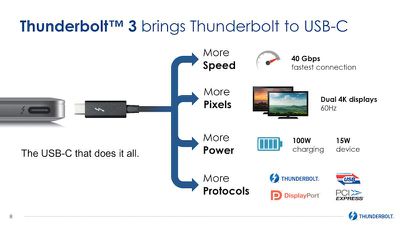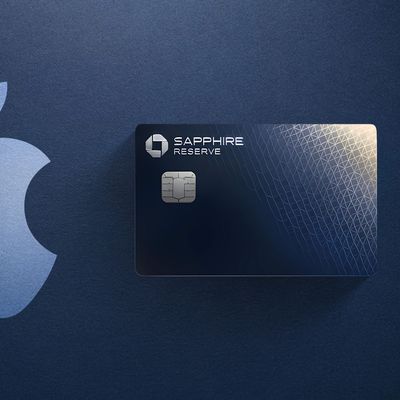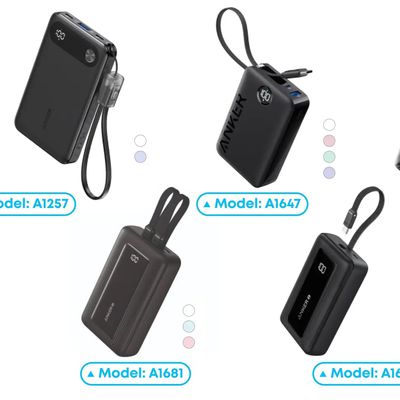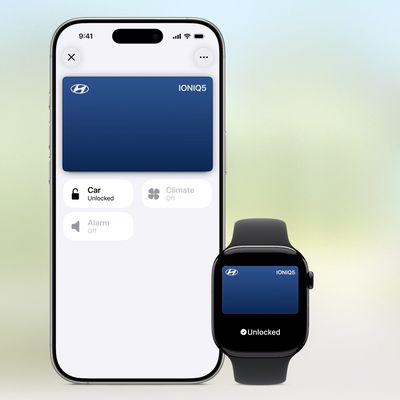Intel Announces Thunderbolt 3 With USB-C, Single-Cable Support for Dual 4K Displays at 60Hz
Intel today at Computex 2015 unveiled Thunderbolt 3 with a USB Type-C connector, instead of Mini DisplayPort, and support for USB 3.1, DisplayPort 1.2 and PCI Express 3.0, as outlined by Ars Technica. The new spec's Thunderbolt transport layer provides up to 40Gbps throughput, double the max bandwidth of Thunderbolt 2, alongside an optional 100 watts of power for charging devices in accordance with the USB Power Delivery spec, or 15 watts of power without USB PD.
"Thunderbolt 3 is backed by Intel's new Alpine Ridge controller. USB 3.1 support is provided by integrating a USB 3.1 host controller into Alpine Ridge. There will be two flavours of the controller, one that uses four PCIe 3.0 lanes to drive two Thunderbolt ports, and another version that only uses two PCIe lanes connected to a single Thunderbolt port."

Thunderbolt 3 is capable of driving up to two 4K external displays at 60Hz or a single 5K display at 60Hz running off a single cable. Dell and other manufacturers currently use a dual-cable solution for most 4K and 5K external displays, since the current DisplayPort/Thunderbolt spec does not provide enough bandwidth to drive the high-resolution monitors. Thunderbolt 3 also supports more protocols than any other I/O controller, making it compatible with virtually any dock, device or display.
Intel expects initial products with Thunderbolt 3 to start shipping before the end of this year, and ramp up in 2016. Thunderbolt 3 is rumored to launch alongside Intel's next-generation Skylake chips, succeeding the Broadwell line, later this year, and the new spec could theoretically be included in Skylake-based Macs that could possibly be released in late 2015. Refreshed Macs would likely gain USB-C ports integrated with Thunderbolt 3 as an all-in-one solution.
Popular Stories
Apple hasn't updated the AirPods Pro since 2022, and the earbuds are due for a refresh. We're counting on a new model this year, and we've seen several hints of new AirPods tucked away in Apple's code. Rumors suggest that Apple has some exciting new features planned that will make it worthwhile to upgrade to the latest model.
Subscribe to the MacRumors YouTube channel for more videos.
Heal...
Chase this week announced a series of new perks for its premium Sapphire Reserve credit card, and one of them is for a pair of Apple services.
Specifically, the credit card now offers complimentary annual subscriptions to Apple TV+ and Apple Music, a value of up to $250 per year.
If you are already paying for Apple TV+ and/or Apple Music directly through Apple, those subscriptions will...
Popular accessory maker Anker this month launched two separate recalls for its power banks, some of which may be a fire risk.
The first recall affects Anker PowerCore 10000 Power Banks sold between June 1, 2016 and December 31, 2022 in the United States. Anker says that these power banks have a "potential issue" with the battery inside, which can lead to overheating, melting of plastic...
In 2020, Apple added a digital car key feature to its Wallet app, allowing users to lock, unlock, and start a compatible vehicle with an iPhone or Apple Watch. The feature is currently offered by select automakers, including Audi, BMW, Hyundai, Kia, Genesis, Mercedes-Benz, Volvo, and a handful of others, and it is set to expand further.
During its WWDC 2025 keynote, Apple said that 13...
Apple's next-generation iPhone 17 Pro and iPhone 17 Pro Max are around three months away, and there are plenty of rumors about the devices.
Apple is expected to launch the iPhone 17, iPhone 17 Air, iPhone 17 Pro, and iPhone 17 Pro Max in September this year.
Below, we recap key changes rumored for the iPhone 17 Pro models:Aluminum frame: iPhone 17 Pro models are rumored to have an...
Apple last month announced the launch of CarPlay Ultra, the long-awaited next-generation version of its CarPlay software system for vehicles.
There was news this week about which automakers will and won't offer CarPlay Ultra, and we have provided an updated list below.
CarPlay Ultra is currently limited to newer Aston Martin vehicles in the U.S. and Canada. Fortunately, if you cannot...
Apple will finally deliver the Apple Watch Ultra 3 sometime this year, according to analyst Jeff Pu of GF Securities Hong Kong (via @jukanlosreve).
The analyst expects both the Apple Watch Series 11 and Apple Watch Ultra 3 to arrive this year (likely alongside the new iPhone 17 lineup, if previous launches are anything to go by), according to his latest product roadmap shared with...
Apple is planning to launch a low-cost MacBook powered by an iPhone chip, according to Apple analyst Ming-Chi Kuo.
In an article published on X, Kuo explained that the device will feature a 13-inch display and the A18 Pro chip, making it the first Mac powered by an iPhone chip. The A18 Pro chip debuted in the iPhone 16 Pro last year. To date, all Apple silicon Macs have contained M-series...





















